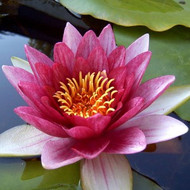Aquatic Plants
Published by Dan on Aug 7th 2018
Aquatic plants are plants that grow only in water or permanently saturated soil. They can be beautiful additions to your water garden or Koi pond. However, you should take some time to learn about the types of aquatic plants and their advantages and disadvantages before adding them to your water garden or Koi pond.
Aquatic plants are plants that grow only in water or permanently saturated soil. They can be beautiful additions to your water garden or Koi pond. However, you should take some time to learn about the types of aquatic plants and their advantages and disadvantages before adding them to your water garden or Koi pond.
See our Aquatic Plant Supplies Section
There are four general categories of aquatic plants. The first is submerged plants, as known as oxygenating plants. Shallow water plants, or bog plants, grow naturally along the edge of the water. Third is floating plants, which are rooted in the top section of the soil and whose flowers and leaves float about the surface. Lastly, there are true floating plants, whose roots are submerged, but also float in the water along with the leaves and flowers.
Aquatic plants are beautiful and unique, but they can be difficult to grow. Shallow water aquatic plants, including cannas and irises, grow best in containers. However, floating plants are best suited for growing in water gardens. Examples of these plants are tropical water lilies, hardy water lilies, and lotus.
The major disadvantage of aquatic plants is that they can be invasive. Certain varieties, especially true floating plants, are particularly invasive, and for this reason, should only be planted in containers. There are some species of aquatic plants that are illegal to grow in certain areas, as they are considered “nuisance aquatic species.” Some examples of nuisance aquatic species include: Duck lettuce, African oxygenweed, Common reed, and Water spinach.
After deciding what varieties of aquatic plants to use in your water garden, you must decide where to purchase the plants. Unfortunately, many plants are treated so roughly in shipping, that once you get them home, they have no chance for survival. You might ask around in your area to find a reputable dealer in aquatic plants.
Once you purchase your aquatic plants, make sure conditions are right for them to thrive. Aquatic plants need adequate light, preferably ten to twelve hours a day. Soil should be covered with a couple of inches of gravel. As you might guess, the water in your water garden is vital. The water temperature should stay in the seventies and water should not be allowed to stagnate.
Remember that it will take some time for your aquatic plants to get used to their new environment. Do not be alarmed if the plants lose their leaves, and certainly do not remove the plants. Give the aquatic plants several days to adjust, and then they will start to rebound.
You can also grow aquatic plants in Koi ponds. Koi ponds will be larger than water gardens. The amount and variety of plants you can grow will be limited, because Koi eat aquatic plants.
After some research and careful decision making, you will find that aquatic plants can make a great addition to your water garden or Koi pond. Once your aquatic plants are used to your new home, they will likely thrive, if kept under certain conditions. You will be able to enjoy the aquatic plants in your water garden or Koi pond for years to come!

